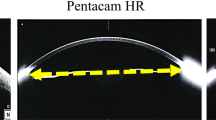Abstract
Purpose
To evaluate the effect of interpupillary distance (IPD) on stereoacuity using 2 kinds of stereoacuity tests in a normal population.
Methods
The distance stereoacuities of 33 healthy volunteers with no evidence of ocular diseases were measured with the Frisby Davis distance (FD2) stereotest and a 3-dimensional monitor-based distance stereotest (distance 3-D stereotest). These 2 kinds of stereotests were repeated using horizontal periscopes to increase the IPD 2- and 3-fold in order to investigate the effect of IPD increase on stereoacuity.
Results
The mean age of the participants was 28.5 years (range 20–41 years). The mean logarithms of the individual minimum angle of stereodiscrimination (logMAS) were 1.04 ± 0.23 (range 0.70–1.48 logMAS) with the FD2 stereotest and 1.52 ± 0.19 (range 1.00–1.85 logMAS) with the distance 3-D stereotest. As the IPD increased 2- and 3-fold, the logMAS measured with the FD2 stereotest improved from 1.04 to 0.98 and 0.91 (P = 0.061 and P = 0.003), respectively, and those measured with the distance 3-D stereotest worsened from 1.52 to 1.73 and 1.85 (P < 0.001 and P < 0.001), respectively.
Conclusions
Changes in IPD measured with the FD2 stereotest exhibited opposite effects to those measured with the distance 3-D stereotest. This reflects what is known to happen in the real world, i.e., that stereoacuity improves as IPD increases.





Similar content being viewed by others
References
Von Noorden GK, Campos EC. Binocular vision and ocular motility: theory and management of strabismus. 6th ed. St Louis: Mosby; 2002. p. 21–5.
Parks MM. Binocular vision. In: Tasman W, Jaeger EA, editors. Duane’s clinical ophthalmology, vol. 1. Philadelphia: Lippincott; 2000. http://www.oculist.net/downaton502/prof/ebook/duanes/pages/v1/v1c005.html (Accessed 28 July 2012).
Adams WE, Hrisos S, Richardson S, Davis H, Frisby JP, Clarke MP. Frisby Davis distance stereoacuity values in visually normal children. Br J Ophthalmol. 2005;89:1438–41.
Stathacopoulos RA, Rosenbaum AL, Zanoni D, Stager DR, McCall LC, Ziffer AJ, et al. Distance stereoacuity: assessing control in intermittent exotropia. Ophthalmology. 1993;100:495–500.
Yildirim C, Altinsoy HI, Yakut E. Distance stereoacuity norms for the mentor B-VAT II-SG video acuity tester in young children and young adults. J AAPOS. 1998;2:26–32.
Holmes JM, Fawcett SL. Testing distance stereoacuity with the Frisby-Davis 2 (FD2) test. Am J Ophthalmol. 2005;139:193–5.
Breyer A, Jiang X, Rutsche A, Mojon DS. A new 3D monitor-based random-dot stereotest for children. Invest Ophthalmol Vis Sci. 2006;47:4842–6.
Kriegbaum-Stehberger B, Jiang X, Mojon DS. Performance of a new, 3D-monitor based random-dot stereotest for children under 4 years of age. Graefes Arch Clin Exp Ophthalmol. 2008;246:1–7.
Kim J, Yang HK, Kim Y, Lee B, Hwang JM. Distance stereotest using a 3-dimensional monitor for adult subjects. Am J Ophthalmol. 2011;151:1081–6.
Jimenez R, Perez MA, Garcia JA, Gonzalez MD. Statistical normal values of visual parameters that characterize binocular function in children. Ophthalmic Physiol Opt. 2004;24:528–42.
MacLachlan C, Howland HC. Normal values and standard deviations for pupil diameter and interpupillary distance in subjects aged 1 month to 19 years. Ophthalmic Physiol Opt. 2002;22:175–82.
Leske DA, Birch EE, Holmes JM. Real depth vs randot stereotests. Am J Ophthalmol. 2006;142:699–701.
Hong SW, Park SC. Development of distant stereoacuity in visually normal children as measured by the Frisby-Davis distance stereotest. Br J Ophthalmol. 2008;92:1186–9.
Frisby Davis Distance Stereotest Manual. Sheffield: Stereotest Ltd; 2007. p. 4–6.
Spencer S, Firth AY. Stereoacuity is affected by induced phoria but returns toward baseline during vergence adaptation. J AAPOS. 2007;11:465–8.
Legge GE, Gu YC. Stereopsis and contrast. Vision Res. 1989;29:989–1004.
Lovasik JV, Szymkiw M. Effects of aniseikonia, anisometropia, accommodation, retinal illuminance, and pupil size on stereopsis. Invest Ophthalmol Vis Sci. 1985;26:741–50.
Acknowledgments
This research was supported by the Basic Science Research Program of the National Research Foundation of Korea (NRF) funded by the Ministry of Education, Science and Technology of South Korea (Grant Number 2010-0007817).
Author information
Authors and Affiliations
Corresponding author
About this article
Cite this article
Eom, Y., Song, JS., Ahn, SE. et al. Effects of interpupillary distance on stereoacuity: the Frisby Davis distance stereotest versus a 3-dimensional distance stereotest. Jpn J Ophthalmol 57, 486–492 (2013). https://doi.org/10.1007/s10384-013-0253-9
Received:
Accepted:
Published:
Issue Date:
DOI: https://doi.org/10.1007/s10384-013-0253-9




